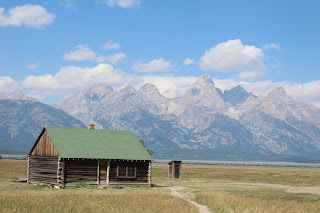 |
| Cunningham Cabin |
No matter how long a vacation, there’s always a feel when it runs up again its final day.
When you’re surrounded by Grand Teton National Park, it ‘s easy not to think about it too much, not when the weather provide the clearest day yet under the Teton Range. The jagged mountains were crisp as they were going to get, making it a perfect day to venture out under their influence.
Not far from the Moran entrance, the park’s substantial bison herd grazed at a safe distance. Close to 600 bison call Grand Teton home. This herd had at least 80 animals. Some bison grazed, others lounged in the tall grasses. Several bulls had entered mating rituals and butted heads, making their displays of dominance. Several others stood back and let cowbirds pick for insects on their hides. It wasn’t just a few birds – some larger bison had close to a dozen on their backs.
The wind blew harshly along the short trail to the Cunningham Cabin, one of Grand Teton’s surviving homesteads. Built by a small creek whose banks ran thick with wildflowers, the cabin was built in 1888 by J.P. Cunningham and predates the permanent residence he would later build.
The two-room cabin could have been plucked directly from one of the many Westerns filmed in Jackson Hole, especially the homesteaders in Shane. The wind whipped through the quiet creek near where the Cunningham Cabin stood. The ceilings were low and the windows small, but every view west was beautiful.
I wonder how much that consoled hardworking homesteader trying to eke out existence on this land. With the creek nearby it probably proved fruitful, although I can only imagine Jackson Hole winters in a thin-walled cabin. Cunningham’s cabin spoke at us from the valley’s rough-and-tumble era, where homesteaders had to fear cattle barons.
Further down the road the houses of Mormon Row added a splash of color to the sage-covered plains. Like the cabin, Mormon Row’s houses, barns and outhouses cut a majestic look when framed in front of the Tetons.
Yes, especially the outhouse – if only its door faced west, one could do their business and stare at the Tetons. Quickly I realized the door had to face the house’s backdoor, since one might need to reach the outhouse in some ugly weather. We followed Mormon Row away from the houses, to a quiet plain where antelope grazed.
The small town of Kelly lies along the Gros Ventre River (pronounced “Grow Von”), as well as the park’s largest campground. Thanks to a few nearby buttes, the Gros Ventre campground lacks any views of the Teton Range, although it lies nestled in a cottonwood grove along the Gros Ventre. Not a bad tradeoff, and it’s still a place to post up in the park.
We drove a little way along the Gros Ventre, turning around at a resort area. Aspen groves were thick on both sides of the road in places. The quiet pool of Kelly Warm Springs had no visitors this morning. Sometimes elk and bison hang around, especially in springtime. Kelly Hot Springs runs about 80 degrees and fosters some unpleasantness such as E. coli and brain-eating amoebas. So no wading was in store.
 |
| The best view going |
 |
| More of Mormon Row |

We ended up at Colter Bay Village for a pizza lunch, then went for a hike around the river braids that run at Schwabacher Landing. The landing no longer has enough water to launch boats onto the Snake, but it has a number of ponds impounded by beaver dams.
On the Snake floodplain, where some of the most famous Teton pictures had been taken, there was a stream of people that never felt too heavy.
We briefly contended with wedding parties, which came with party buses that had no business being down there. But they had permits, and the road had not restrictions beyond being narrow.

To take a few stabs at wildlife, we headed down a few of the roads that get light traffic and eventually branch into the national forests ringing the park.
 |
| Two Ocean Lake |
From the road we ended up at the south end of Two Ocean Lake, a prime spot for a kayak/canoe float without anyone else around. The lone wildlife came off a creek entering the lake, where a garter snake twisted among roots on a steep bank.
The last gasp at wildlife came as the golden hour descended up on the Cattleman’s Bridge Site just north of Oxbow Bend. The road, where a bridge used by cattle ranchers once crossed the Snake, winds among the underbrush and overgrown trees to a small beach where canoes and kayaks can launch.
We can upon an odd bird stalking something from the road. We realized it was a ptarmigan. Having never seen one of these birds, which changes its feathers from brown to white as winter arrives, it counts as an unexpected pleasure. The ptarmigan leapt into the brush to catch whatever it was stalking.
After leaving the Cattlemen site, daylight started creeping away. With the smoke moving out, the night was a little darker, the galactic core details deepening. After a full day of clear views to the Teton Range, I probably felt like they shined a little brighter anyway.
 |
| Jenny Lake shore |







No comments:
Post a Comment